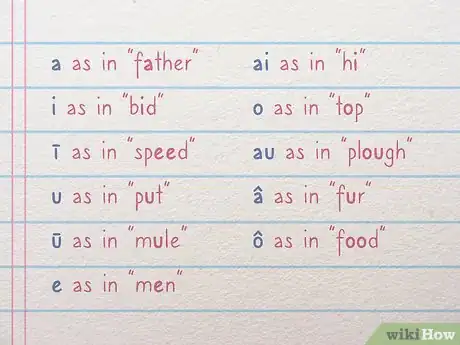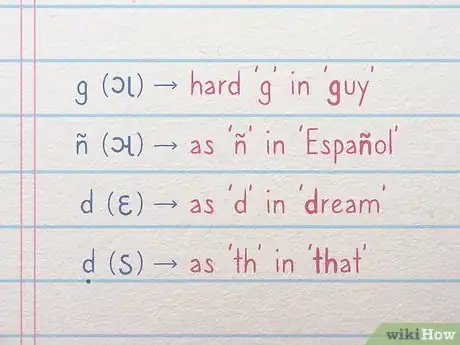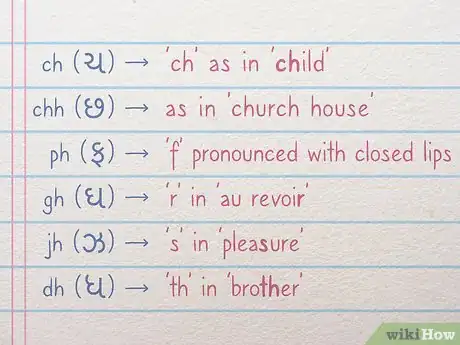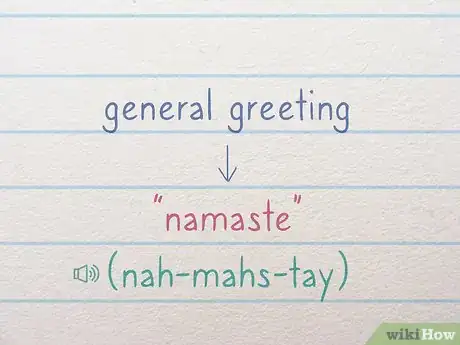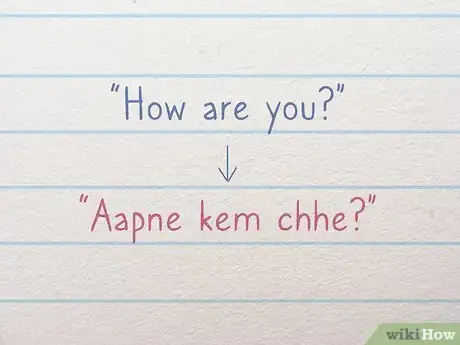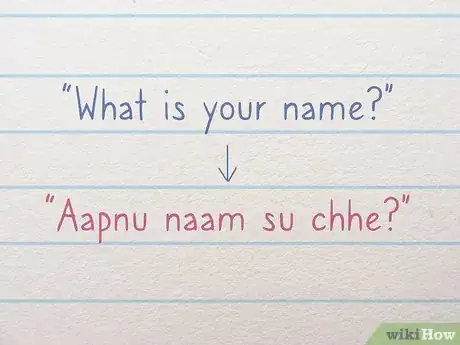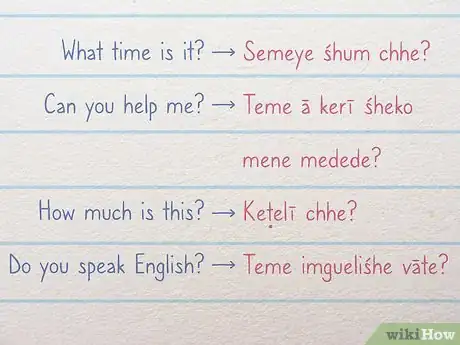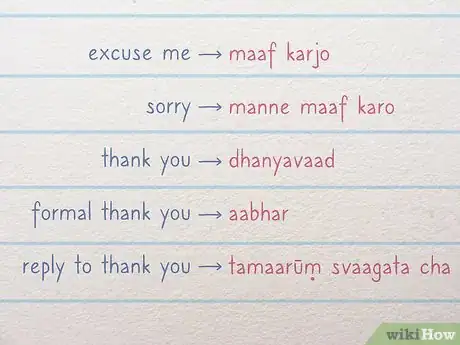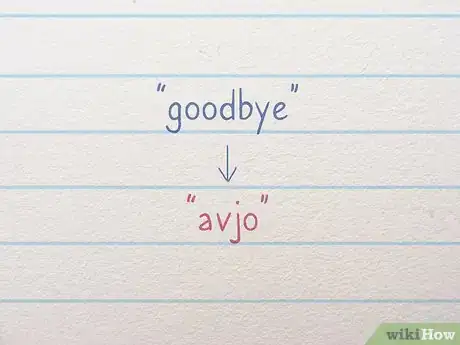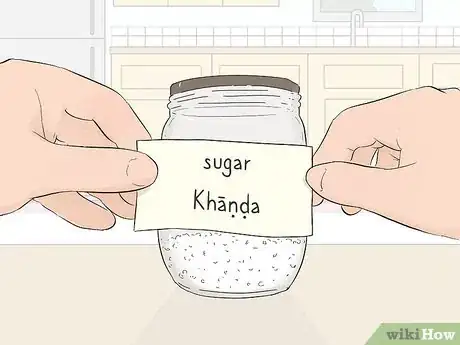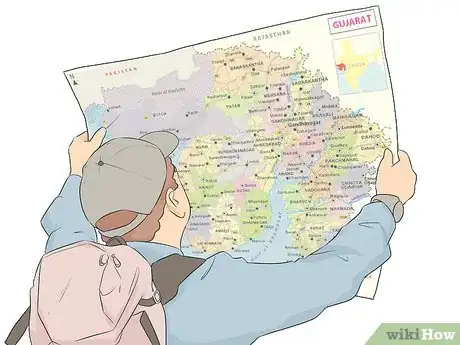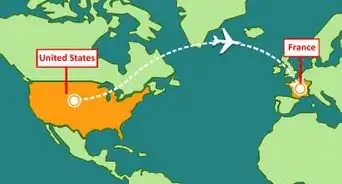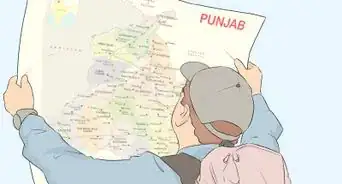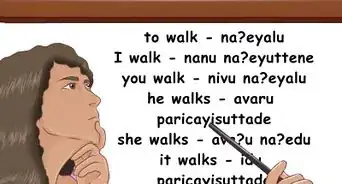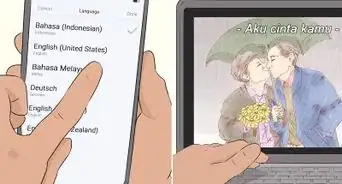This article was co-authored by Tian Zhou and by wikiHow staff writer, Jennifer Mueller, JD. Tian Zhou is a Language Specialist and the Founder of Sishu Mandarin, a Chinese Language School in the New York metropolitan area. Tian holds a Bachelor's Degree in Teaching Chinese as a Foreign Language (CFL) from Sun Yat-sen University and a Master of Arts in Teaching English to Speakers of Other Languages (TESOL) from New York University. Tian also holds a certification in Foreign Language (&ESL) - Mandarin (7-12) from New York State and certifications in Test for English Majors and Putonghua Proficiency Test from The Ministry of Education of the People's Republic of China. He is the host of MandarinPod, an advanced Chinese language learning podcast.
There are 9 references cited in this article, which can be found at the bottom of the page.
This article has been viewed 54,200 times.
Gujarati is an Indo-Aryan language spoken by around 46 million people living primarily in India, Bangladesh, and Fiji. If you want to learn how to speak Gujarati, start by learning how to pronounce the alphabet. Then you'll be able to sound out any word you see in Gujarati. From there, you can move on to having basic conversations. Immersing yourself in the language is a good way to become more familiar with the language as well as the Gujarati culture.[1]
Steps
Pronouncing the Alphabet
-
1Start with basic vowel sounds. Many Gujarati vowels have sounds that will be familiar to you if you speak English. Knowing the correct vowel sounds is essential if you want to pronounce Gujarati words correctly. Gujarati vowel sounds include:[2]
- a as in the English word "father"
- i as in the English word "bid"
- ī as in the English word "speed"
- u as in the English word "put"
- ū as in the English word "mule"
- e as in the English word "men"
- ai as in the English word "hi"
- o as in the English word "top"
- au as in the English word "plough"
- â as in the English word "fur"
- ô as in the English word "food"
Tip: Gujarati script uses a syllabic alphabet, in which each consonant has an inherent vowel sound. Vowels can be written either as independent letters or as diacritical marks added above, below, before, or after a consonant.
-
2Learn single consonants that have no English equivalent. Most of the single consonants used in Gujarati make the same sound as English consonants you may already be familiar with. However, there are a few that have sounds you won't find in English. Some of these distinct consonants are:[3]
- g (ગ) always sounds like the hard "g" in the English word "guy"
- ñ (ઞ) sounds like the "ñ" in the Spanish word "Español"
- d (દ) sounds like the "d" in the English word "dream" or saying a d sound while putting your tongue on your front teeth. However, ḍ (ડ) sounds like the "th" in the English word "that."
Advertisement -
3Move on to consonant blends. Some Gujarati consonants are formed by blending an "h" with another consonant to form a distinct sound. While some of these have English equivalents, many do not. Common consonant blends include:[4]
- ch (ચ) as in the English word "child"
- chh (છ) has two "h" sounds, like saying the "ch" followed by the "h" in the English words "church house"
- ph (ફ) sounds like the "p" followed by the "h" in the English words "tap him." Unlike in English, this blend does not produce an "f" sound.
- gh (ઘ) sounds like the "r" in the French phrase "au revoir" or like the combination of "bug him"
- jh (ઝ) can sound like the z in "zebra", or like the j and h in "taj house
- dh (ધ) sounds like the "d" in the English word door. However, ḍh (ઢ) sounds closer to the "th" in the English words "brother" or "the".
Making Basic Conversation
-
1Say "namaste" (નમસ્તે) to greet people generally. If you are familiar with any Indian language or with Indian culture generally, you are likely familiar with "namaste." This is a general greeting that is appropriate with anyone, regardless of their age or your level of familiarity with them.[5]
- When greeting a Gujarati Muslim, "salaam" (સલામ) may be more appropriate.[6]
Tip: You can also say "suprabhat" (good morning) in the morning. "Shubh sandhya" is an evening greeting, but it is archaic and seldom used.
-
2Follow up with "aapne kem chhe" to ask someone how they're doing. After greeting someone, ask "Aapne kem chhe?" This is a more formal way to ask someone "How are you?" Use it with older people or people you don't know.[7]
- With people your age and younger, or people you know well, you can say "Tame kem chho?" Many Gujarati people will shorten this to "Kem chho (કેમ છો)?"
- To reply, say "mane saru chhe" (મને સારુ છે; formal) or "hu maja ma chhu" (હુ મજા મા છુ; informal).
-
3Ask the person their name by saying "Aapnu naam shu chhe?" (આપ્નુ નામ શું છે?) This is the formal version of this question, so it's appropriate to use with anyone you don't know. If you're talking to someone much younger than you, such as a child, you might ask "Taru naam shu chhe?" (તારુ નામ શું છે?)[8]
- To reply, say "maru naam" followed by your name, then "chhe." Don't worry about trying to translate your name into Gujarati. For example, if your name was Adam, you would say "Maru naam Adam chhe."
Tip: When someone tells you their name, you might say "tamne maline anand thaiyo," which means "pleased to meet you."
-
4Learn a few more basic questions. Use basic questions to kickstart a conversation. If you don't understand what the person says in response to your question, you might say "mane samajan padti nathi" (I don't understand) or "tame krupa karine farithi kehsho" (please say that again). Good questions to learn include:[9]
- Semeye śhum chhe? (What time is it?)
- Teme ā kerī śheko mene medede? (Can you help me?)
- Keṭelī chhe? (How much is this?)
- Teme imgueliśhe vāte? (Do you speak English?)
-
5Use polite words and phrases to show respect. In any culture, it's important to mind your manners. Native speakers will treat you much more kindly if you learn some basic polite words and phrases. Words you should know in Gujarati include:[10]
- maaf karjo (excuse me/pardon)
- manne maaf karo (sorry)
- dhanyavaad (thank you)
- aabhar (formal thank you)
- tamaarūṃ svaagata cha (reply to thank you)
-
6End the conversation with "avjo." The word "avjo" means "goodbye" and is suitable to use with anyone. Its literal meaning is closer to "come back some other time," but it is understood to mean that you are taking your leave.[11]
- You can also repeat "namaste," since this word is used both as a greeting and a farewell.
Immersing Yourself in the Language
-
1Listen to Gujarati music. Music lyrics are slower than regular speech, so you can work on your pronunciation. Additionally, the repetitive nature of lyrics helps to drill phrases into your head more easily. Gujarati culture has a rich musical tradition of classics and folk tunes, as well as more recent popular artists.[12]
- The Times of India has many trending Gujarati music videos available at https://timesofindia.indiatimes.com/videos/entertainment/music/gujarati.
- Your favorite music streaming service may also have Gujarati playlists or channels that you can listen to.
-
2Watch films and videos in Gujarati. Watching Gujarati films or online videos can be a great way to learn the language. You may be able to find Gujarati films on streaming services. Also, search for videos on YouTube.
- Unscripted television shows and videos are typically better for learning a language than scripted films and shows. With a script, you won't get as good of an idea of how normal people regularly talk and carry on a conversation.
-
3Talk to a native speaker on a regular basis. When learning to speak any new language, talking to a native speaker is the best way to become more comfortable speaking and perfect your pronunciation. If there aren't any Gujarati speakers who live near you, search online for a language partner.[13]
- Language exchange websites typically connect you with a native Gujarati speaker who wants to learn English or another language you're fluent in. They help you with your Gujarati and in exchange, you help them with their English. Most of these websites are free, although you may be able to get premium services for a monthly fee.
- You can also find tutors online who will talk to you in one-on-one video sessions. You'll typically pay an hourly rate for these tutors, although many are reasonably priced.
Tip: When using a language exchange website, take care to safeguard your private information. Avoid getting into personal conversations with your language exchange partner, especially at first.
-
4Label objects around your house with the Gujarati word. Use sticky notes or another non-damaging method to write the Gujarati word for various objects in and around your home. Put the labels in a place where you'll easily see them several times a day. Over time, your brain will start to automatically associate the object with the Gujarati word instead of the English word.[14]
- You can find vocabulary lists for free online. For example, an extensive vocabulary list is available at https://www.ocr.org.uk/Images/70104-vocabulary-list.pdf.
- Once you've memorized the names for objects, you can move to adjectives and verbs. For example, you might learn the Gujarati words for colors by labeling multiple objects with the Gujarati word for their color.
-
5Travel to an area where Gujarati is spoken. In India, Gujarati is primarily spoken in the states of Gujarat, Maharashtra, Rajasthan, Karnataka, and Madhya Pradesh. There are also large groups of Gujarati speakers in Bangladesh, Fiji, Oman, Pakistan, and many countries in Africa.[15]
- If you live in the US or the UK, you may find large populations of Gujarati speakers living near you. For example, there is a large community of Gujarati speakers in Blackburn in the UK.[16]
- The best way to become fluent in any language is to immerse yourself in the target language environment.
Warnings
- The pronunciations in this article are only approximate, not exact. The correct pronunciation of Gujarati sounds may require you to put your tongue in a different position in your mouth than you would if you were speaking English. Listening to and speaking with a native speaker will help you improve your pronunciation.⧼thumbs_response⧽
References
- ↑ https://www.omniglot.com/language/phrases/gujarati.php
- ↑ http://mylanguages.org/gujarati_alphabet.php
- ↑ http://mylanguages.org/gujarati_alphabet.php
- ↑ http://mylanguages.org/gujarati_alphabet.php
- ↑ https://reference.yourdictionary.com/other-languages/gujarati-language-words.html
- ↑ https://culturalatlas.sbs.com.au/indian-culture/indian-culture-greetings
- ↑ https://www.omniglot.com/language/phrases/gujarati.php
- ↑ https://www.omniglot.com/language/phrases/gujarati.php
- ↑ http://mylanguages.org/gujarati_questions.php
- ↑ https://reference.yourdictionary.com/other-languages/gujarati-language-words.html
- ↑ https://www.omniglot.com/language/phrases/gujarati.php
- ↑ https://www.lingualift.com/blog/learning-languages-through-music-singing/
- ↑ https://blog.ted.com/how-to-learn-a-new-language-7-secrets-from-ted-translators/
- ↑ https://blog.ted.com/how-to-learn-a-new-language-7-secrets-from-ted-translators/
- ↑ https://www.omniglot.com/writing/gujarati.htm
- ↑ https://www.bbc.com/news/10512704
- ↑ https://www.omniglot.com/writing/gujarati.htm
